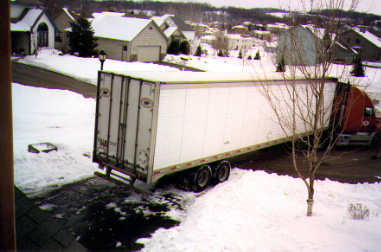Moving the Falco
![]()
Moving the Falco |
|
by David Gibb
This article appeared in the March 1998 Falco Builders Letter. |
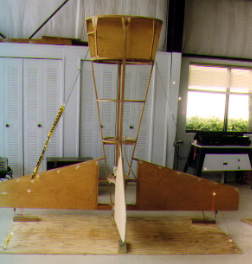
In late November of 1996 I heard Jim Kennedy was interested in talking to me about selling his Falco project. Those who know Jim are aware of this meticulous construction standards. The opportunity presented me with two problems. First, I was well into my own Falco project with the tail section completed and the wing jigs built. In addition, our shops are 2000 miles apart; mine in Minnesota and Jim's in Florida.
Jim was 18 years and 5000 hours into his project. The wing was covered and fuselage frames/longerons were glued and resting on the strongback jig. Over the years he had acquired all the kits, a 600 hour IO-320, new prop and books filled with various articles and builders letters Sequoia had released on the Falco. As an aside, I have spent hours reading all the information he had collected and appreciate even more the early builders and their pioneering journeys.
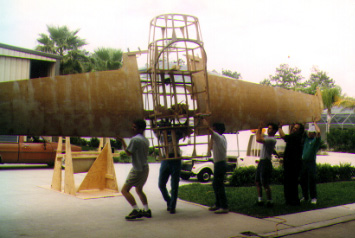
Transporting this airframe was not going to be easy. While the wing had structural strength, the fuselage was at a fragile stage. Splitting the fuselage at Frame #8 and transporting the project firewall down left us with a structure 27 feet long x 4 feet wide x 8 feet 4 inches high. We figured if we could focus on safe movement of the primary structure the rest of the load would be incidental.
Jim headed the design of transportation jigs, and I focused on logistics. Many options were considered including a flatbed, a rail piggyback, and building a custom trailer. The largest rental trucks fell short in length and height. With a January temperature swing from +70° in Florida to 30° in Minnesota U was also concerned with rain, snow and other weather we might encounter, as well as the change in humidity. I thought I had a truck/rail solution that might work, but I could not be assured exclusive use of the trailer. I just about fell over when the insurance quote alone came in, in excess of $6000. As I learned later, classifying the load as aircraft parts rather than as aircraft would get insurance at 1/10th the cost.
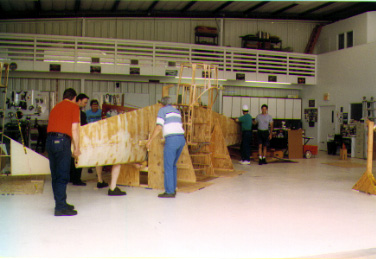
During my search for suitable transportation, I was put in contact with a retiring trucking firm owner/operator in his 80's who was intrigued by the challenge of moving a homebuilt and stepped up to the challenge. He scheduled exclusive use of a 52 foot air ride trailer, a husband /wife tag team that would drive nonstop, and a date to be ready to load. The only hitch was we would have the standard two hour window to load the cargo in Florida. As luck would have it the move date ran concurrent with Biker Week in Daytona Beach (motorcycles by the thousands), and our tag team was into the biker craze. Jim traded truck keys even up; his Ford Ranger for their Kenworth, and the drivers were off to biker activities.
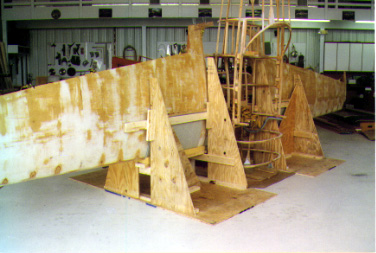
The moving jig design evolved over many faxes over several weeks, and Jim's engineering approach to problem solving. By the time I flew to Florida in late January, the jigs were all precisely precut and awaiting assembly. Typical of Jim, the workmanship on the jigs was up to the same standards as that of the airframe. The final product was a sling that would support the primary structure by the leading edges of the wings. The design would allow the firewall to "float" 1-2 inches off the floor. The tail section was carried with the rudder and elevator hinges anchored to a 4 x 8 foot sheet of plywood. The result was both fuselage frame #8's were up in the air. The engine and extra plywood were individually crated as were many of the larger parts. On the advice of our truckers everything was anchored only to the trailer floor with nothing to the sides or top of the trailer. As they explained, when a semi travels down the road rocking from side to side, the corners do not stay true right angles. This movement could be rough on any fragile structure.
The actual loading took just over 6 hours with help from a number of Jim's neighbors. Spruce Creek, the fly-in community where Jim and Doris Kennedy live, is filled with pilots who understand the fragile and personal nature of our cargo. Space was not a concern since we had exclusive use of the trailer. We loaded the engine, crates, boxes and propeller in the front of the trailer, and partitioned that section off. The two main structures were loaded in the center. Last to be loaded was the plywood and jigs used for setup.
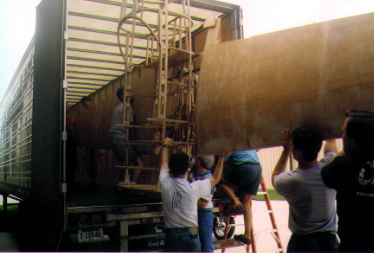
Our tag team departed Daytona Beach Wednesday evening and were scheduled to arrive in Minneapolis on Friday morning. Through GPS our Falco could be tracked within 3 minutes via the trucking dispatcher. I met the team as the exited the freeway and escorted them the last 2 miles to our shop. While motorcycles were nowhere to be seen (keep in mind it was 30°F before the wind chill) the Mall of America gave our drivers a diversion while we unloaded. My teenage son lined up 8 schoolmates and a teacher so we had plenty of muscle (some would argue no shortage of expertise either, but that is another story). In less than two hours we were unloaded, set up, and starting the environmental conditioning. To get Florida humidity in our heated Minnesota shop, we used a combination of humidifiers and the steam equipment used for bending wood. At 48 hour intervals we would adjust the humidity downward until we reached a moisture content appropriate for our part of the country.
My Christmas present, a laser level, was used to do the final leveling. I recommend this tool be added to the "must have" tool category. With its laser beam accuracy, alignment was, and continues to be, a snap.
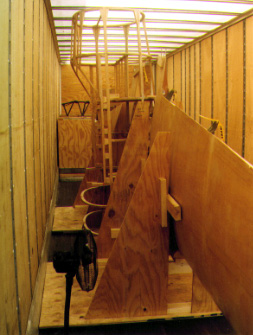
Four items were critical to the successful move as measured by no nicks, scratches, or cracking of wood. First was the thorough planning. Countless faxes and phone calls preceding the move made the execution run like clockwork. Second was a buyer and seller both committed to a successful move. Dividing the workload allowed Jim and me to keep focused. Third was support from Alfred and Susan at Sequoia and input from Dave McMurray, by builder-mentor on the West Coast. The fourth was leaving the long drive to professionals. The total transportation and insurance cost was just under $3500 and worth every cent. While they drove, I flew commercial and was mentally ready for the unloading at the other end.
It has been 12 months since the move, and Jim still checks in from time to time. At this point we are skinning the fuselage and hope to have a flying Falco by the turn of the century.
